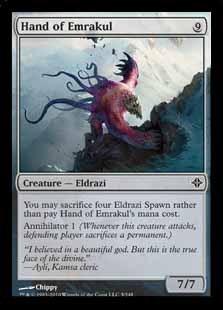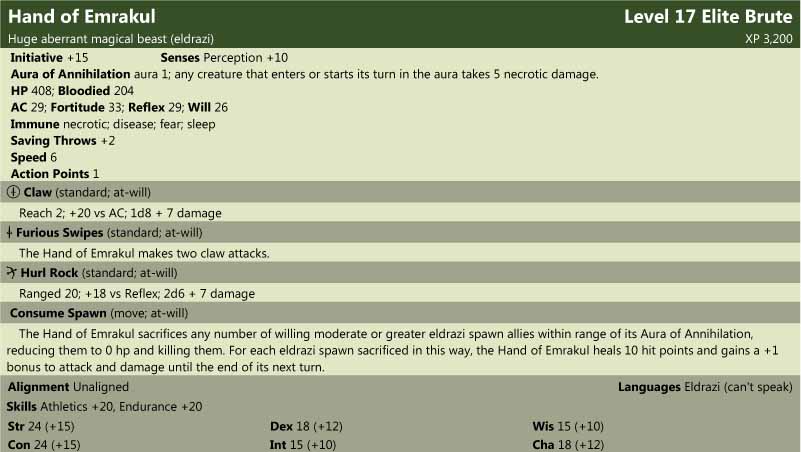A History of
Blood Powers
June 7th, 2010
Hello and welcome to Undead Week. For those of you thinking to yourselves something like wait, undead week? What are you talking about? I wasn’t informed of this!, it’s true, this is the first we’ve mentioned it. For the next few months (longer, if it seems to be working) we’ll be doing two theme-weeks a month (roughly every other week) in which all of our articles will be written about a certain topic. These restrictions help breed creativity in our writing staff, as Mark Rosewater will be happy to tell you about (search for “restrictions” if you’re not a magic player or otherwise aren’t interested in the design of rebound, for some reason), and as I may one day write an article about as well. In the meantime, this is undead week, not theme week week (an interesting theme idea if I ever heard one) and my editor is brandishing a stapler at me menacingly, so let’s get back on topic.
Because this week is undead week, it seemed like the perfect time to pull out a column I wrote about our vampire-centric first supplement, Liber Vampyr, but never quite got around to posting. Originally it was entitled “Ghosts of Vampires Past,” but due to a clerical error that name was given to this article, which was originally titled “Subtypes of Power.” Anyway, I hope you find the following article entertaining—or at least informative. And, of course, if you aren’t interested in Liber Vampyr (available for free in our downloads section) and just want some Eldrazi stat blocks, you’ll find the Hand of Emrakul down below.
Hello everyone. I’d like to spend today’s Dark Designs column giving you a quick run-through of Liber Vampyr, our premiere sourcebook which revolutionizes the role of blood-sucking monsters in D&D and allows you to play the game in a whole new way. Of course, you probably shouldn’t take my word on that: after all, I designed the thing, so you could say I’m just a little bit biased. Your best bet for a fair and impartial review would be to just go download the thing: it’s free. And if you still want all the juicy design stories, well, I’ll still be here when you get back.
The typical reaction I get when I say that our book is designed to make vampire characters more accessible to players is “well, if I wanted to play a vampire game, White Wolf already has a perfectly good one.” This is true, and in many ways it is a fair point. On the other hand, while Vampire: the Requiem is an excellent product, there are a number of things that it doesn’t do. First and foremost among these, it doesn’t convert very nicely into Dungeons and Dragons. It isn’t designed to allow for fantasy campaigns, and it is very much not designed to allow for mixed parties, where only one member of the group is a vampire. What’s more, some people just prefer the D&D engine to the one White Wolf uses. The goal wasn’t to create a groundbreaking vampire game, the goal was to bring existing vampire gaming technology and infuse it into the Dungeons and Dragons engine.
The first step in really making “vampire” easily accessible to players was, I think, making it a class. When it comes to D&D, class is one of, if not the, most defining aspects of a character. Specific abilities (feats, spells, alternate class features, etc.) are important, and by no means is a character defined solely by their class in even the most mechanically-minded way (that is to say, the real most important aspect of a character is their personality, but as a designer that’s largely out of my hands). A class that was based around being a vampire wasn’t entirely unprecedented: vampire myth certainly allows for the idea that the more time someone spends as a vampire, and theoretically by extension the more training one does in tapping their vampiric potential, the more powerful a vampire becomes. Classes, ultimately, represent how the character chooses to train him or herself to be a better adventurer. It’s more or less a match made in heaven.
Enter Ghostwalk, a 3rd edition supplement which tried to make ghost characters more accessible to player characters, and which attempted to broaden the way ghosts could be used in D&D. Sound a little familiar? Tell me about it. Blood powers began existence as Vampire Feats, and were a more-or-less shameless fusion of Vampire: the Requiem’s Disciplines and Ghostwalk’s ghost feats, basically transforming the idea of the former into the mechanics of the latter. The finished product, for the most part, doesn’t really reflect this, with only a few odd abilities betraying any connection to Vampire: the Requiem (most notably in Detect Thoughts, Vampiric). The presence of Ghostwalk’s influence lingered a little more, most notably in the fact that, despite being spell-like abilities more akin to the maneuvers of the Book of Nine Swords, nearly all blood powers have prerequisites which require you having taken most, if not all, of the previous powers in a given family.
The design for three different classes of vampires came from the beginning, and as much as I would love to say that it was an attempt to “fill out” the Ghostwalk classes (which included only mage and fighter), I have to admit that here I was drawing on Morrowind and its three vampire clans, which, like everything in Morrowind, were divided along the lines of Strength, Stealth, and Sorcery. Originally the stealth class was going to be rogue, which is far more iconic of stealth classes (monk essentially being a bridge between stealth and strength, anyway), but there were some hurdles in development, and after trying monk instead we just never really looked back, it felt so right.
I really wanted to tell a story about how blood powers wound up being fueled by draining blood, a renewable resource gained from fighting, and something that, to my knowledge, is a D&D first. It sounds like a really exciting story. I’m pretty sure it isn’t, though, because I can’t for the life of me remember how it happened.
And now, the Hand of Emrakul

Hand of Emrakul (CR 13)
XP 25,600
N Huge aberration (extraplanar, eldrazi)
Init +2; Senses low-light vision, darkvision, blindsight; Perception +27
Aura Aura of Annihilation
DEFENSE
AC 28, touch 10, flat-footed 26 (+2 Dex, +18 natural, –2 size)
hp 199 (19d8+114)
Fort +12, Ref +10, Will +18
Defensive Abilities rock catching; Immune critical hits, disease, energy drain, massive damage, mind-affecting, negative energy, poison, sleep, stunning SR 24
OFFENSE
Speed 50 ft.
Melee 2 claws +26 (2d6+14)
Ranged rock +15 (4d6+21)
Space 15 ft.; Reach 15 ft.
Special Attacks consume spawn, rock throwing (140 ft.)
STATISTICS
Str 39, Dex 14, Con 23, Int 2, Wis 20, Cha 15
Base Atk +14; CMB +30; CMD 42
Feats Awesome Blow, Cleave, Combat Reflexes, Improved Bull Rush, Lightning Reflexes, Improved Sunder, Improved Vital Strike, Iron Will, Power Attack, Vital Strike
Skills Climb +17, Perception +27
Languages Eldrazi (can’t speak)
SQ
SPECIAL ABILITIES
Aura of Annihilation (Su): Any living creature who moves or begins his turn within 20 feet of the Hand of Emrakul takes 2d6 negative energy damage. For each point of negative energy damage dealt this way, the Hand of Emrakul heals 1 hit point.
Consume Spawn (Su): As a standard action, the Hand of Emrakul can absorb the life essence stored in nearby Eldrazi spawn. The Hand of Emrakul sacrifices any number of willing Eldrazi spawn who are within range of his aura of annihilation, reducing them to 0 hit points and destroying them utterly. For each Eldrazi spawn sacrificed in this way, the Hand of Emrakul heals 2d6 hit points. The Hand of Emrakul also gains an enhancement bonus to its Strength score based on the number of Eldrazi spawn sacrificed:
Eldrazi Spawn Sacrificed |
# of spawn per 1 point of Strength bonus |
1-5 |
1 spawn per 1 Strength |
6-15 |
2 spawn per 1 Strength |
16-35 |
3 spawn per 1 Strength |
36+ |
4 spawn per 1 Strength |
This bonus lasts for 5 rounds, and separate instances of this ability do not stack: use the higher of the two bonuses, instead. For example, if the Hand of Emrakul sacrifices 21 spawn, he will heal 42d6 hit points and gain a +12 enhancement bonus to his Strength score (5 for the first 5 spawn, 5 for the next 10 spawn, and 2 for the final 6 spawn). Any effect which prevents the death of the Eldrazi spawn prevents them from granting the Hand of Emrakul any benefits through this ability.
ECOLOGY
Environment any
Organization solitary
Treasure incidental
Or, in 4e-ese...



